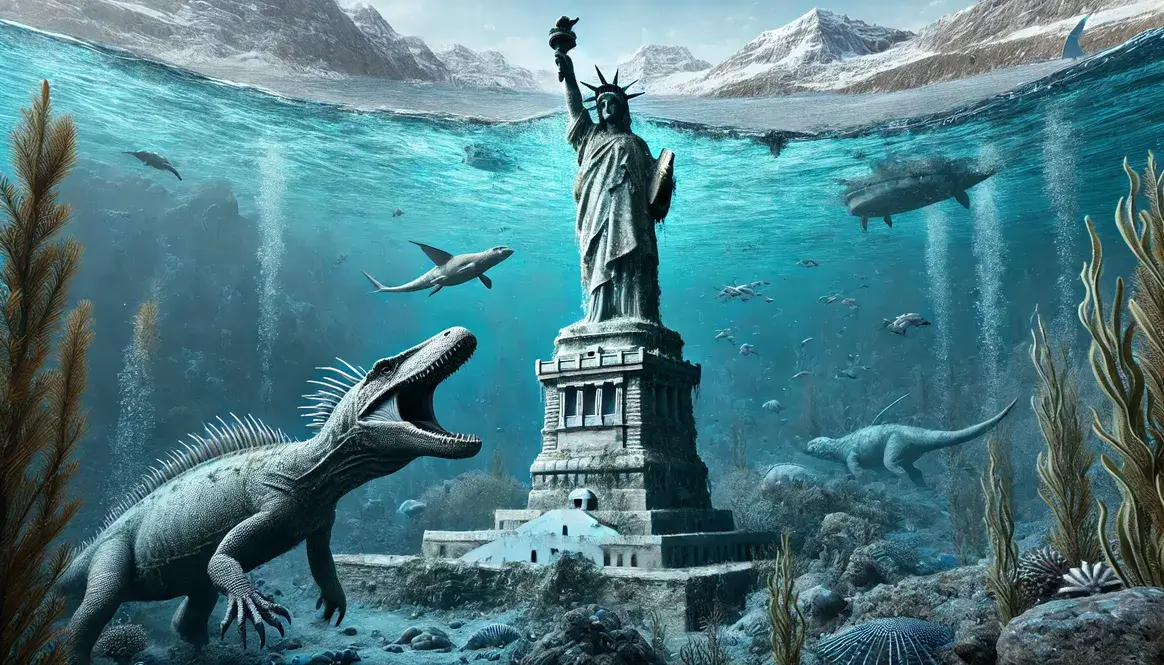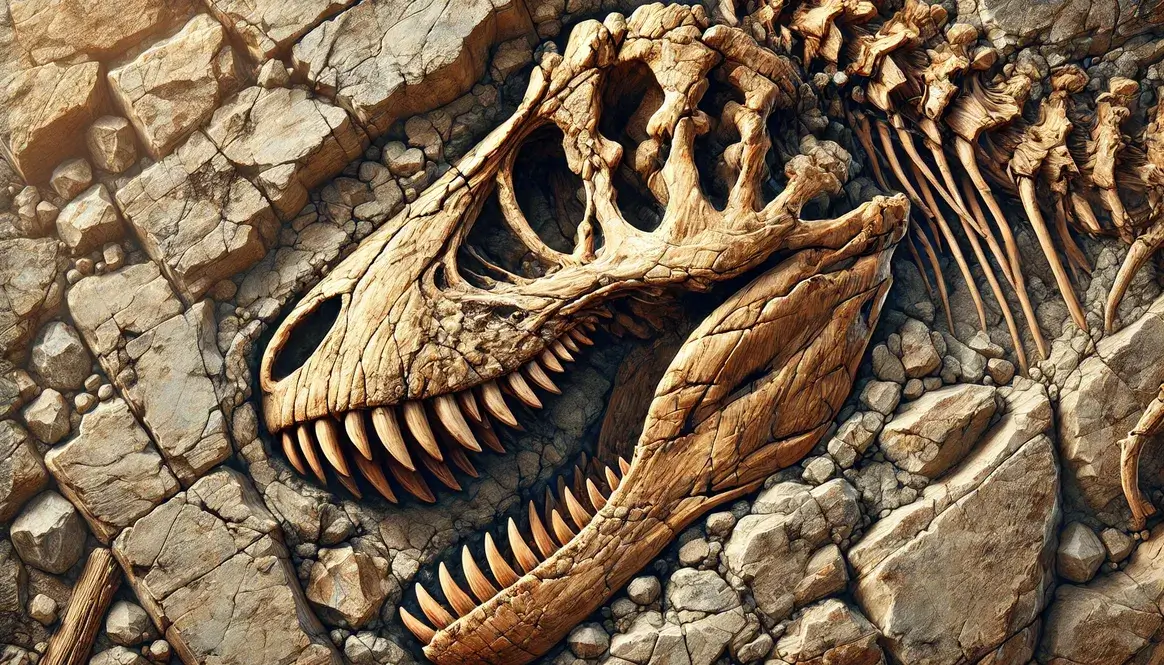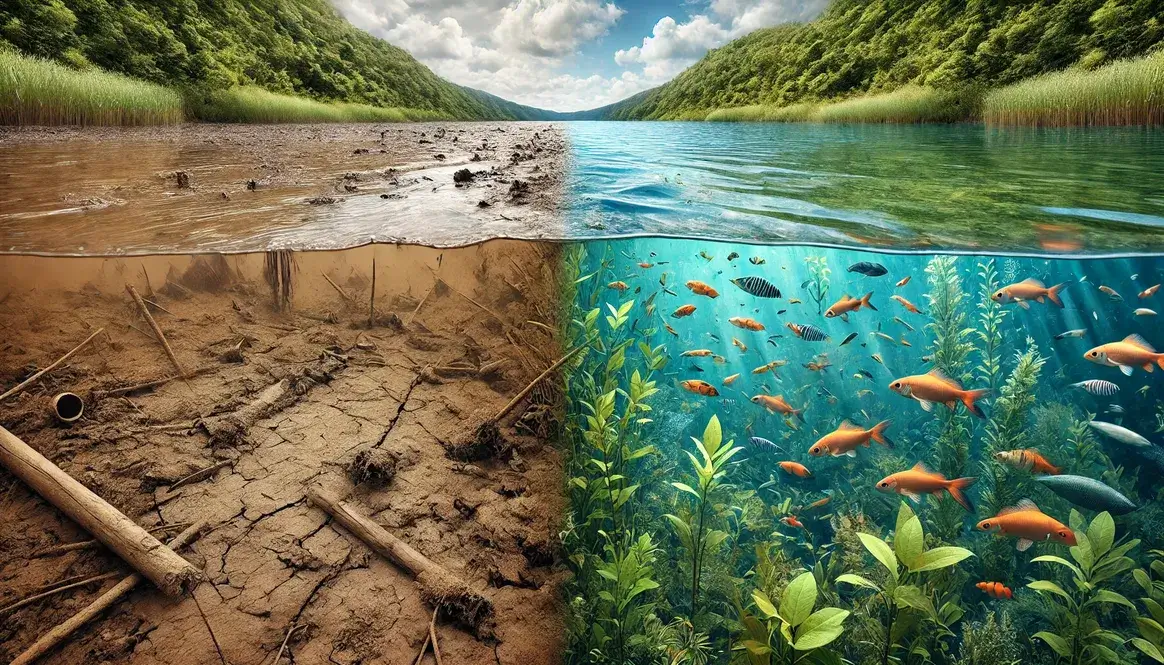During the Cretaceous period, which lasted from about 145 to 66 million years ago, Earth looked very different from today. One of the biggest differences was the height of the sea levels. If you could travel back in time, you’d find oceans much higher than they are now.
How high were sea levels in the Cretaceous? At their peak, Cretaceous sea levels were about 100 to 200 meters (330 to 660 feet) higher than they are today.
These high sea levels had a big impact on the world of the dinosaurs. Many areas that are dry land today were underwater during the Cretaceous. This created new habitats for marine life and changed the way dinosaurs and other land animals lived and moved around.
| Cretaceous Sea Level Facts | Details |
|---|---|
| Peak Height Above Present | 100-200 meters (330-660 feet) |
| Main Causes | Increased seafloor spreading, absence of polar ice caps |
| Impact on Continents | Extensive flooding, creation of shallow seas |
| Evidence Source | Geological records, fossil markers, oxygen isotope analysis |
How High Were Sea Levels in the Cretaceous?
Let’s dive deeper into the numbers. Sea levels during the Cretaceous weren’t always at their highest point. They changed over time, just like they do today.
At the start of the Cretaceous, about 145 million years ago, sea levels were already higher than they are now, but not at their peak. As time went on, they kept rising. They reached their highest point in the Late Cretaceous, around 80-100 million years ago.
Here’s a breakdown of sea level changes throughout the Cretaceous:
| Time Period | Years Ago | Sea Level Above Present |
|---|---|---|
| Early Cretaceous | 145-100 million | 50-100 meters (165-330 feet) |
| Mid-Cretaceous | 100-80 million | 100-150 meters (330-490 feet) |
| Late Cretaceous Peak | 80-100 million | 150-200 meters (490-660 feet) |
| End-Cretaceous | 66 million | 100-150 meters (330-490 feet) |
These high sea levels meant that much of the land we know today was underwater. Imagine the coasts of continents being much further inland than they are now!
Measuring Ancient Sea Levels
You might be wondering, “How do scientists know how high sea levels were millions of years ago?” It’s a great question! Researchers use several clever methods to figure this out.
Geological Evidence
One way scientists learn about ancient sea levels is by looking at rocks and sediments. Some types of rocks only form in shallow seas. When scientists find these rocks in places that are now dry land, it tells them that area was once underwater.
Fossil markers are another important clue. Some animals only live in shallow seas. If scientists find fossils of these animals far inland, it’s a sign that sea levels were once much higher.
Scientific Methods
Scientists also use some high-tech methods to measure ancient sea levels:
- Oxygen isotope analysis: This involves studying the chemistry of tiny fossils from the ocean floor. The balance of different types of oxygen in these fossils can tell scientists about past sea levels and temperatures.
- Backstripping techniques: This is like peeling back layers of the Earth’s crust to see what it looked like in the past. Scientists use computer models to remove the effects of things like sediment build-up and the weight of the ocean.
These methods help scientists piece together a picture of what Earth’s oceans looked like millions of years ago.
Measuring Ancient Sea Levels
Geological Evidence
Geologists use various types of rocks and sediments to understand ancient sea levels. Some key indicators include:
- Limestone deposits: These often form in shallow seas and can be found far inland today.
- Coral reefs: Ancient reefs preserved as fossils indicate where shorelines once existed.
- Beach deposits: Old beach sands and gravels found inland show previous coastlines.
Fossil markers play a crucial role too. Scientists look for remains of marine organisms in rocks that are now on dry land. For example, finding fossils of shallow-water clams or marine reptiles in ancient oceans far from today’s coasts is a clear sign of higher sea levels in the past.
Scientific Methods
Modern science has given us powerful tools to study ancient sea levels:
- Oxygen isotope analysis: This method examines the ratio of different oxygen isotopes in marine microfossils. During colder periods with more ice, oceans contain more of the heavier oxygen-18 isotope. By measuring this ratio, scientists can estimate past sea levels and temperatures.
- Backstripping techniques: This complex method involves:
- Removing layers of sediment in computer models
- Accounting for compaction and loading of sediments
- Adjusting for changes in the Earth’s crust due to the weight of water and sediments
These techniques allow researchers to reconstruct ancient landscapes and determine where coastlines were millions of years ago.
Causes of High Cretaceous Sea Levels
The exceptionally high sea levels during the Cretaceous period were the result of several factors working together. Let’s explore the two main causes:
Increased Ocean Ridge Activity
One of the primary reasons for high Cretaceous sea levels was increased activity at mid-ocean ridges. Here’s how it worked:
- Seafloor spreading: This process occurs when tectonic plates move apart at mid-ocean ridges, and new oceanic crust forms.
- Faster spreading: During the Cretaceous, seafloor spreading was happening faster than usual.
- Displacement of water: As new crust formed, it pushed older crust aside, displacing water and causing sea levels to rise.
This increased ocean ridge activity had a significant impact on sea level rise. Scientists estimate that this factor alone could have caused sea levels to rise by 50-100 meters above current levels.
Absence of Polar Ice Caps
Another major factor contributing to high Cretaceous sea levels was the lack of polar ice caps. This was due to:
- Warmer global temperatures: The Cretaceous period was hot, with average temperatures much higher than today.
- No permanent ice sheets: The warmth meant that large ice sheets couldn’t form at the poles.
- More water in the oceans: Without ice caps, water that’s currently locked up in ice was free to raise sea levels.
The absence of polar ice caps had a dramatic effect on sea levels. Today, if all the ice on Earth melted, sea levels would rise by about 70 meters. During the Cretaceous, all of this water was already in the oceans, contributing to the much higher sea levels of the time.
These factors combined to create a world very different from our own, with vast shallow seas covering much of what is now dry land. This Cretaceous climate had a profound impact on the distribution and evolution of life, including the dinosaurs that ruled the Earth during this period.
Impact on Cretaceous Geography
The high sea levels during the Cretaceous period dramatically reshaped Earth’s geography. Let’s explore how these changes affected the continents and coastlines of the prehistoric world.
Flooded Continents
The extent of continental flooding during the Cretaceous was vast. Imagine looking at a map of Earth where familiar landmasses are partly submerged under shallow seas. Here’s what it might have looked like:
- North America: A large sea called the Western Interior Seaway split the continent in two.
- Europe: Much of the continent was an archipelago of islands.
- Africa: The northern part was covered by the Tethys Sea.
- Australia: A shallow sea flooded the central part of the continent.
These flooded areas created major shallow seas that played a crucial role in Cretaceous ecosystems. Some of the most significant shallow seas included:
- The Western Interior Seaway (North America)
- The Tethys Sea (between Africa and Eurasia)
- The Eromanga Sea (Australia)
These shallow seas were teeming with life, including marine reptiles like plesiosaurs and mosasaurs. They also provided important habitats for many species of fish and marine invertebrates.
Changes to Coastlines
The higher sea levels of the Cretaceous led to significant changes in coastal areas:
Expansion of continental shelves
As sea levels rose, they flooded large parts of the continents, creating vast shallow seas. These newly submerged areas formed extensive continental shelves – the gently sloping seafloor extending from the coast to deeper ocean waters.
The expanded continental shelves had several important effects:
- Increased marine habitats
- Enhanced nutrient cycling in coastal waters
- Altered ocean currents and Cretaceous ocean movement
Creation of new marine habitats
The flooding of continents and expansion of continental shelves led to the creation of diverse new marine habitats. These environments supported a wide range of life forms:
- Coral reefs flourished in the warm, shallow waters
- Seagrass meadows provided shelter for small marine creatures
- Estuaries and lagoons offered protected areas for juvenile fish
This abundance of new habitats contributed to the rich biodiversity of the Cretaceous seas. Many of the marine reptiles and fish that we find as fossils today lived in these shallow marine environments.
The changes in geography also affected terrestrial life. Dinosaurs adapted to new environments as their habitats changed, leading to new migration patterns and the evolution of new species adapted to coastal living.
In summary, the high sea levels of the Cretaceous period transformed Earth’s geography, creating a world of shallow seas and islands that was very different from the planet we know today. These changes had profound effects on both marine and terrestrial life, shaping the course of evolution during this fascinating period of Earth’s history.
Sea Level Fluctuations During the Cretaceous
The Cretaceous period wasn’t a time of constant high sea levels. Instead, the oceans rose and fell over millions of years, creating a dynamic environment that shaped the evolution of life on Earth.
Early Cretaceous Levels
At the beginning of the Cretaceous, about 145 million years ago, sea levels were already higher than they are today. However, they weren’t at their highest point yet. Here’s what was happening:
- Sea levels were about 50-100 meters above present levels
- Continents were starting to flood, but not as extensively as later
- The climate was warming, contributing to the rising seas
During this time, many coastal areas became shallow seas, creating new habitats for marine life. These changes set the stage for the incredible diversity of marine reptiles and fish that would evolve over the next 80 million years.
Late Cretaceous Peak
Sea levels reached their highest point during the Late Cretaceous, around 80-100 million years ago. This peak had dramatic effects on the planet:
- Maximum flooding: Sea levels rose to 150-200 meters above present levels
- Extensive shallow seas: Large parts of continents were submerged
- Thriving marine ecosystems: The expanded oceans supported diverse life forms
This period saw the evolution of many famous marine reptiles, like mosasaurs, which dominated the seas. On land, dinosaurs adapted to changing coastlines and new island habitats.
End-Cretaceous Changes
As the Cretaceous period drew to a close, sea levels began to fall, though they remained high by today’s standards. This decline was likely due to several factors:
- Slowing of seafloor spreading rates
- Slight global cooling
- Possible formation of small ice sheets
Despite this drop, sea levels at the end of the Cretaceous were still about 100-150 meters higher than they are now. These changes had significant impacts on marine and terrestrial life, setting the stage for the dramatic events at the end of the Cretaceous.
It’s important to note that these sea level changes happened slowly over millions of years, unlike the rapid changes we’re seeing today due to human-induced climate change. The gradual nature of these ancient changes allowed life to adapt and evolve in response to the changing environment.
Understanding these sea level fluctuations helps us appreciate the dynamic nature of Earth’s climate and geography over geological time scales. It also provides context for studying how climate affected dinosaur evolution and the eventual extinction of non-avian dinosaurs at the end of the Cretaceous period.
Sea Levels and Cretaceous Marine Life
The high sea levels during the Cretaceous period had a profound impact on marine life, leading to an explosion of diversity and the evolution of some of the most fascinating creatures in Earth’s history.
Expansion of Marine Ecosystems
As sea levels rose, vast new areas of shallow sea were created. These environments provided ideal conditions for marine life to thrive:
- Increased habitat area: More space for marine organisms to live and evolve
- Diverse ecosystems: Coral reefs, seagrass meadows, and coastal lagoons flourished
- Nutrient-rich waters: Shallow seas supported abundant plankton growth
This expansion of marine ecosystems led to an incredible diversity of life forms. From microscopic plankton to giant marine reptiles, the Cretaceous seas were teeming with activity.
Impact on Marine Reptile Diversity
The high sea levels of the Cretaceous coincided with a golden age for marine reptiles. These ancient ocean dwellers evolved to fill various niches in the expanded marine environments:
- Mosasaurs: Large, predatory lizards that became top predators in late Cretaceous seas
- Plesiosaurs: Long-necked marine reptiles that thrived in shallow seas
- Ichthyosaurs: Fish-like reptiles that dominated early Cretaceous oceans
The diversity of these marine reptiles was closely tied to the available habitats created by high sea levels. As shallow seas expanded, so did the opportunities for these creatures to evolve and diversify.
Comparing Cretaceous and Modern Sea Levels
Understanding the differences between Cretaceous and modern sea levels can help us appreciate the dynamic nature of Earth’s climate and geography.
Key Differences
Let’s compare Cretaceous and modern sea levels:
| Aspect | Cretaceous | Modern |
|---|---|---|
| Average sea level | 100-200m higher | Current baseline |
| Polar ice caps | Absent | Present |
| Flooded land area | Extensive | Limited |
| Shallow seas | Widespread | Less common |
| Rate of change | Gradual (millions of years) | Rapid (decades) |
These differences highlight how dramatically Earth’s geography can change over geological time scales.
Implications for Future Climate Change
Studying Cretaceous sea levels provides valuable insights into potential future scenarios:
- Long-term consequences: While current sea level rise is much faster than in the Cretaceous, it shows us the potential long-term effects of sustained higher temperatures.
- Ecosystem changes: The Cretaceous demonstrates how rising seas can create new habitats and drive evolution. Today, we need to consider how rapid changes might affect modern ecosystems.
- Coastal impacts: Cretaceous coastlines were very different from today’s. This can help us understand how our coasts might change with rising seas, albeit on a much faster timescale.
- Climate feedback loops: The Cretaceous climate, with its high carbon dioxide levels, can inform our understanding of potential future climate scenarios.
While the Cretaceous world was very different from ours, studying its high sea levels helps scientists better understand the complex relationships between climate, sea levels, and life on Earth. This knowledge is crucial as we face the challenges of human-induced climate change and rising seas in our modern world.









